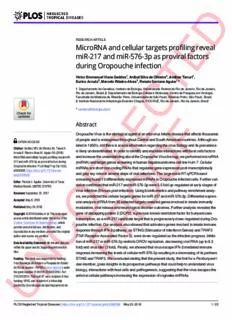
MicroRNA and cellular targets profiling reveal miR-217 and miR-576-3p as proviral factors during PDF
Preview MicroRNA and cellular targets profiling reveal miR-217 and miR-576-3p as proviral factors during
RESEARCHARTICLE MicroRNA and cellular targets profiling reveal miR-217 and miR-576-3p as proviral factors during Oropouche infection VictorEmmanuelVianaGeddes1,AnibalSilvadeOliveira2,AmilcarTanuri1, EuricoArruda2,MarceloRibeiro-Alves3,RenatoSantanaAguiar1* 1 DepartamentodeGene´tica,InstitutodeBiologia,UniversidadeFederaldoRiodeJaneiro,RiodeJaneiro, RiodeJaneiro,Brazil,2 DepartamentodeBiologiaCelulareMolecular,CentrodePesquisaemVirologia, FaculdadedeMedicinadeRibeirãoPreto,UniversidadedeSãoPaulo,RibeiraoPreto,SãoPaulo,Brazil, a1111111111 3 InstitutoNacionaldeInfectologiaEvandroChagas,FIOCRUZ,RiodeJaneiro,RiodeJaneiro,Brazil a1111111111 a1111111111 *[email protected] a1111111111 a1111111111 Abstract OropoucheVirusistheetiologicalagentofanarbovirusfebrilediseasethataffectsthousands ofpeopleandiswidespreadthroughoutCentralandSouthAmericancountries.Althoughiso- OPENACCESS latedin1950’s,stillthereisscarceinformationregardingthevirusbiologyanditsprevalence Citation:GeddesVEV,deOliveiraAS,TanuriA, islikelyunderestimated.Inordertoidentifyandelucidateinteractionswithhostcellsfactors ArrudaE,Ribeiro-AlvesM,AguiarRS(2018) MicroRNAandcellulartargetsprofilingrevealmiR- andincreasetheunderstandingabouttheOropoucheVirusbiology,weperformedmicroRNA 217andmiR-576-3pasproviralfactorsduring (miRNA)andtargetgenesscreeninginhumanhepatocarcinomacelllineHuH-7.Cellular Oropoucheinfection.PLoSNeglTropDis12(5): miRNAsareshortnon-codingRNAsthatregulatesgeneexpressionpost-transcriptionally e0006508.https://doi.org/10.1371/journal. andplaykeyrolesinseveralstepsofviralinfections.ThelargescaleRT-qPCRbased pntd.0006508 screeningfound13differentiallyexpressedmiRNAsinOropoucheinfectedcells.Furthervali- Editor:PatriciaV.Aguilar,UniversityofTexas dationconfirmedthatmiR-217andmiR-576-3pwere5.5foldup-regulatedatearlystagesof MedicalBranch,UNITEDSTATES virusinfection(6hourspost-infection).Usingbioinformaticsandpathwayenrichmentanaly- Received:September22,2017 sis,wepredictedthecellulartargetsgenesformiR-217andmiR-576-3p.Differentialexpres- Accepted:May8,2018 sionanalysisofRNAfrom95selectedtargetsrevealedgenesinvolvedininnateimmunity Published:May29,2018 modulation,viralreleaseandneurologicaldisorderoutcomes.Furtheranalysisrevealedthe Copyright:©2018Geddesetal.Thisisanopen geneofdecappingprotein2(DCP2),apreviousknownrestrictionfactorforbunyaviruses accessarticledistributedunderthetermsofthe transcription,asamiR-217candidatetargetthatisprogressivelydown-regulatedduringOro- CreativeCommonsAttributionLicense,which poucheinfection.Ouranalysisalsoshowedthatactivatorsgenesinvolvedininnateimmune permitsunrestricteduse,distribution,and responsethroughIFN-βpathway,asSTING(StimulatorofInterferonGenes)andTRAF3 reproductioninanymedium,providedtheoriginal authorandsourcearecredited. (TNF-ReceptorAssociatedFactor3),weredown-regulatedastheinfectionprogress.Inhibi- tionofmiR-217ormiR-576-3prestrictsOROVreplication,decreasingviralRNA(upto8.3 DataAvailabilityStatement:Allrelevantdataare withinthepaperanditsSupportingInformation fold)andvirustiter(3fold).Finally,weshowedthatvirusescapeIFN-βmediatedimmune files. responseincreasingthelevelsofcellularmiR-576-3presultinginadecreasingofitspartners Funding:Thisworkwassupportedbyfunding STINGandTRAF3.Weconcludedstatingthatthepresentstudy,thefirstforaPeribunyaviri- fromFundac¸ãodeAmparoàPesquisadoEstado daemember,givesinsightsinitsprospectivepathwaysthatcouldhelptounderstandvirus doRiodeJaneiro-FAPERJ(www.faperj.br)under biology,interactionswithhostcellsandpathogenesis,suggestingthatthevirusescapesthe thegrantnumber:E-26/010.001562/2014,Ref.: 210.022/2014.RSAandATwererecipientofthat antiviralcellularpathwaysincreasingtheexpressionofcognatesmiRNAs. funding.VEVGwasrecipientofafellowship grantedbyCoordenac¸ãodeAperfeic¸oamentode PLOSNeglectedTropicalDiseases|https://doi.org/10.1371/journal.pntd.0006508 May29,2018 1/25 miR-217andmiR-576-3pareproviralfactorsforOropouchereplication PessoaldeN´ıvelSuperior-CAPES(www.capes. gov.br)underthegrantnumber:1545985.The Authorsummary fundershadnoroleinstudydesign,datacollection andanalysis,decisiontopublish,orpreparationof OropoucheViruscausestypicalarboviralfebrileillnessandiswidelydistributedintropi- themanuscript. calregionofAmericas,mainlyAmazonregion,associatedwithcasesofencephalitis. Competinginterests:Theauthorshavedeclared 500,000peopleareestimatedtobeinfectedwithOropoucheworldwideandsomestatesin thatnocompetinginterestsexist. BrazildetectedhighernumberofcasesamongotherarbovirusessuchasDengueandChi- kungunya.Asmuchasclimatechange,humanmigrationandvectorandhostavailability mightincreasetheriskofvirustransmission.Despiteitsestimatedhighprevalencein CentralandSouthAmericapopulations,theliteratureconcerningthemainaspectsof viralbiologyremainscarceandbegantobeinvestigatedonlyinthelasttwodecades. Nonetheless,littleisknownaboutvirus-hostcellinteractionsandpathogenesis.Virus infectionregulatescellularpathwayseitherpromotingitsreplicationorescapingfrom immuneresponsethroughmicroRNAs.KnowingwhichmicroRNAsandtargetgenesare modulatedininfectioncouldgiveusnewinsightstounderstandmultipleaspectsofinfec- tion.Here,wedepictedcandidatemiRNAs,genesandpathwaysaffectedbyOropouche Virusinfectioninhepatocytecells.Wehopethisworkserveasguidelineforprospective studiesinordertoassessthecomplexityregardingtheorthobunyavirusesinfections. Introduction OropoucheVirus(OROV)istheetiologicalagentofOropouchefever,anarthropod-borne viraldiseasecharacterizedbysymptomslikefever,headache,myalgia,arthralgia,malaise,pho- tophobia,nausea,vomiting,dizziness,skinrash,andinfewcasesencephalitisandmeningitis [1–7].ItwasfirstdescribedinTrinidadin1955[8]andthefirstBrazilianstrainwasisolated fromadeadpale-throatedthree-toedsloth(Bradypustridactylus)nearahighwayconstruction campsiteinBele´m,Para´state,northernBrazil[9].Itisestimatethatmorethan500,000people wereinfectedinatleast30outbreaksinSouthandCentralAmericabetween1961and2009[8, 10,11,12],placingOropouchefeverasoneofthemostprevalentarboviraldiseaseinsome statesofBrazil,afterDengue,ChikungunyaandYellowFever.However,theviruspathogenesis isstillobscure,andOropouchefeverisstillconsideredaneglecteddisease.Duringurbanout- breaks,thevirusismainlytransmittedbyitsmajortransmissionvector,themidgeCulicoides paraensis[3,9,13].Otherinsectspecies,likemosquitoesofthegenusAedesandCulex,might alsobepotentialvectors[9].OROVisclassifiedintheorderBunyavirales,Peribunyaviridae family,Orthobunyavirusgenus,asBunyamweraVirus,LaCrosseVirusandtherecentlydis- coveredSchmallenbergVirus[14].TheorderBunyaviralesisthelargestvirusorder,contain- ingseveralvirusesimplicatedintheetiologyofrelevanthumandiseases,suchasLaCrosse Virus(LACV)andOropoucheVirus(Orthobunyavirus),RiftValleyFeverVirus(RVFV) (Phlebovirus),Crimean-CongoFeverVirus(CCFV)(Orthonairovirus)andtherodent-borne HantaanVirus(HTNV),AndesVirus(ANDV)andSinNombreVirus(SNV)(Orthohanta- virus).OROVhasatri-segmentednegativestrandRNAgenomewithasmallsegment(S)that encodesthenucleocapsidproteinNandanon-structuralproteinNSs;amedium(M)segment thatencodestheglycoproteinsGcandGnandanothernon-structuralprotein,NSm,anda large(L)segmentthatencodestheviralRNA-dependentRNApolymerase(RdRP)[15]. DespiteitsrelevanceasahumanpathogenanditshighprevalenceinSouthAmerica,littleis knownaboutOROVreplicativecycle,pathogenesisandvirus-hostinteractions.Arecent studydemonstratedthattheOROVentryinHeLacellsisdependentonclathrin-coatedpits [16].AnotherreportshowedtherelevanceofMAVS,IRF-3andIRF-7,componentsofthe PLOSNeglectedTropicalDiseases|https://doi.org/10.1371/journal.pntd.0006508 May29,2018 2/25 miR-217andmiR-576-3pareproviralfactorsforOropouchereplication innateimmuneresponse,inrestrictingOROVinfectioninknockoutmicemodelsandnon- myeloidcells[17].Despitethat,theviruspathogenesisandthecellularpathwaysregulatedby OROVinfectionarenotknownindetail.Geneexpressionandpost-transcriptionalregulation ismediatedbyshortnon-codingRNAs(microRNAs,miRNAsormiR)thatplaysimportant rolesduringvirusreplication. MicroRNAsspanbetween19–22nucleotidesinlengthandtheirfirstdescriptionwasmade innematodes[18,19],thoughnowtheyhavebeenidentifiedinseveralphylaofplantsandani- mals[20],andeveninviralgenomes[21].Inmammals,theycanbegeneratedfromintronic andexonicregionsofprotein-codinggenesorintergenicregions[22].Theycanbefoundas singlemiRNAgenesorinclustersthatencodeslongprecursormolecules,thepri-miRNA, rangingfromhundredtothousandnucleotidesinlength[23,24].Pri-miRNAsbeginstobe editedinthenucleusbytheenzymeDroshaintopre-miRNAs,shorter70nucleotideslong moleculeswithhairpinstructures[25,26].Thosepre-miRNAsareexportedfromthenucleus intothecytoplasmbyproteinssuchasexportin5andRAN-GTP[27],andarefurtherpro- cessedbyDicerintoa22nucleotideslongdouble-strandedRNA(commonlyreferredas miRNA:miRNA(cid:3))[28,29].Thedouble-strandedRNAisloadedintoanArgonaute-driven RNAinducedsilencingcomplex(RISC),whichselectsonestrandandbindstoatargetmRNA (commonlyinthe3’-untranslatedregion,or3’-UTRregion)[30,31]bybasecomplementarity. ThemiRNAinteractionwithitstargetmRNAinducesgenesilencingbydegradation(when fullcomplementaritybetweenthemiRNAandthetargetsequenceoccurs)[32],ortransla- tionalinhibition(incaseofpartialcomplementarity)[33,34].Sincetheseedsequence(the minimalcomplementaritysitebetweenmiRNAandmRNA)isusually7–8nucleotideslong,a singlemiRNAcouldregulatesexpressionofseveralgenes,aswellasasinglegenecouldbereg- ulatedbymanymiRNAs[35,36]. MiRNAshavealreadybeendescribedinfluencingdiseaseprogression,pathogenicityand replicativecycleofseveralviruses,beingeitherinhibitoryorstimulatoryoftheinfection[37, 38].Theliver-specificmiRNA-122stimulatesHCVtranslation,stabilizingandprotectingthe 5’-UTRofviralRNAsfromdegradation,leadingtoanaccumulationofthesameinthecyto- plasm[39–42].InrestingCD4+Tlymphocytes,HIV-1viralproductionisimpairedbycellular miRNAsthatcontributetoestablishthevirallatency[43].AnothermiRNA,miR-29a,targets HIV-1RNAtoaccumulateinRNAprocessingbodies(P-bodies),inhibitingvirusinfection throughtranslationsuppression[44].Evendifferentstrainsofthesameviruscanelicitdiffer- entmiRNAregulationresponses,asdemonstratedforthehighly-pathogenicavian-derived InfluenzaAH7N7strainandthelow-pathogenicswine-derivedInfluenzaAH1N1strain[45], suggestingthatmiRNAsignatureprofilescouldraisecluesaboutpathogenicityvariation. ConcerningmiRNAregulationbybunyaviruses,astudywithpathogenicandnon-patho- genicstrainsofhantavirusesdemonstratedthevariationonmiRNAprofileamongthediffer- entspecie-specificvirusesandcelltypes[46].AnotherstudywiththeHantavirusRespiratory Syndrome(HPS)-causingagent,AndesVirus(ANDV),identifieddown-regulationofmiR- 126expression,amiRNAthatactsasregulatorofSPRED1[47].Increasedexpressionof SPRED1wassuggestedtobeoneofthemechanismsthataugmentendothelialcellspermeabil- ity,leadingtoHPS.ArecentstudywithPBMCofpatientspresentingacutehemorrhagicfever causedbytheCrimean-CongoHemorrhagicFeverVirus(CCHFV)showedthederegulation ofseveralmiRNAs,someofthemassociatedwithinnateimmunityandviralescapemecha- nisms[48].TheonlystudywithphlebovirusesdescribedtheassociationbetweenmiR-142-3p andtheendocyticvesicleproteinVAMP3,suggestingacontrolmechanismfortheintracellu- lartraffickingofUukuniemiVirus(UUKV)[49]. DuetothescarcityofinformationregardingtheregulationofbunyavirusesbymiRNAand theincreasingnecessityofbetterunderstandingofvirus-hostinteractionsofrelevantemerging PLOSNeglectedTropicalDiseases|https://doi.org/10.1371/journal.pntd.0006508 May29,2018 3/25 miR-217andmiR-576-3pareproviralfactorsforOropouchereplication pathogens,weaimedtoevaluateandidentifythecellularmiRNAprofileandtargetgenes inducedbyOROVinfectioninvitro.WedemonstratedthatmiRNAsmiR-217andmiR-576- 3p,differentiallyexpressedduringinfection,couldberegulatingcrucialpathways,likeinnate immunityresponse,mainlyinupstreamproteinsofinterferon-βinductionpathway(adaptor andkinaseproteins,aswellastranscriptionfactors),proteinshutoffandapoptosis. Methods Celllines,virusandinfection CelllinesVero(ATCC,CCL-81),U87-MG(ATCC,HBT-14)andHeLa(ATCC,CCL-2)were maintainedinDMEM(Gibco)supplementedwith10%v/vFetalBovineSerum(FBS)(Gibco) and1%v/vofpenicillin-streptomycin(10.000U/ml-10.000μg/ml)(Gibco)at37˚Cand5% CO .HuH-7cellsweremaintainedinDMEMwithoutsodiumpyruvate(Gibco)supplemented 2 with10%v/vHyCloneserum(GELifeSciences),1%v/vantibiotics,1%200mML-Glutamine (Gibco)and1%v/vnon-essentialaminoacids(Gibco)at37˚Cand5%CO .Jurkat(ATCC, 2 TIB-152)andTHP-1(ATCC,TIB-202)weremaintainedinRPMI-1640medium(Gibco)sup- plementedwith10%v/vFBS,1%v/vantibioticsand1%v/vsodiumbicarbonate(Gibco)at 37˚Cand5%CO .OROVstrainBeAn19991wasoriginallyobtainedfromtheEvandroChagas 2 InstituteandpropagatedbyserialpassagesinVerocellsbyroutinemethodsusingDMEM. TheOROVstockusedinthepresentexperimentswaspropagatedinHeLacellsandtitratedto 2x106PFU/ml.InfectionswereperformedatMOI1during1hat37˚Cand5%CO in 2 mediumwithoutFBS,underbiosafetylevel3conditionsataBSL-3laboratoryatUniversidade FederaldoRiodeJaneiro. Virustitration VirustitrationwasperformedbyplaqueassayinVerocellsplatedat3x105cells/wellin12 wellplates1daypriortoinfection.After1hincubationwiththevirus,cellswerereplenished byDMEMsupplementedwith1%v/vFBS,1%v/vantibioticsand1%v/vcarboxymethylcellu- lose(CMC)(Sigma-Aldrich),andincubatedat37˚Cand5%CO during4days.Cellswere 2 fixedwith4%formaldehydefor20minatroomtemperature,washedinPhosphateBuffered Saline(PBS)(Gibco)andstainedwith20%v/vethanol-violetcrystalsolutionfor15min. THP-1PMAtreatment Inordertoinducemonocyte-to-macrophagedifferentiation,THP-1cellswerestimulatedwith 100nMphorbol12-myristate13-acetate(PMA)(Sigma-Aldrich)instandardRPMImedium for24hor3daysfollowedby5daysincubationatRPMImediumwithoutPMA.FreshRPMI mediumwasprovidedtocellsaftertreatmentandbeforeinfections.THP-1derivedmacro- phagescellswereinfectedasdescribedabove,at24hor8dayspostPMAtreatment. Flowcytometryandimmunofluorescencestaining Cells(105cells/sample)werefixedwith4%paraformaldehydefor20minandpermeabilizedin 1%v/vTritonX-100PBSsolution.Blockingwasperformedin5%v/vDonkeySerum(Sigma- Aldrich)PBSsolutionfor1hat37˚C.OROVinfectedanduninfectedcellswereincubatedwith mousepolyclonalanti-OROVantibodyat1:300dilutioninblockingsolutionat37˚Cfor30 min.CellswerethenwashedthriceinPBSandincubatedwith2μg/mlDonkeyanti-mouse AlexaFluor488secondaryantibody(ThermoFisherScientific)at37˚Cfor30min.Afterincuba- tionwiththesecondaryantibody,cellswerewashedandresuspendedinPBS.Flowcytometry PLOSNeglectedTropicalDiseases|https://doi.org/10.1371/journal.pntd.0006508 May29,2018 4/25 miR-217andmiR-576-3pareproviralfactorsforOropouchereplication wasperformedinAccuriC6cytometer(BDBiosciences).Atleast10,000gatedeventswere countedperexperimentalreplicaatFITCchannel. Cellviabilityassay HuH-7wereplatedat2x104cells/welldensityon96-wellplateandincubatedat37˚Cand5% CO for12h.Afterthat,cellswereinfectedasdescribedabove.Cellviabilitywasevaluatedby 2 CellTiter-Blue(Promega)accordingtomanufacturer’sinstructions.Thefluorescencewasmea- suredatSpectraMaxParadigmMulti-ModeDetectionPlatform(MolecularDevices). RNAisolationandqualityassessment TotalcellularRNAformicroarrayandtargetmRNART-qPCRanalysiswasisolatedusingMir- Vana kit(ThermoFisherScientific)accordingtomanufacturer’sinstructions.RNAquantification andqualitywasassessedby2100BioanalyzerusingRNA6000Nanokit(AgilentTechnologies). OnlysampleswithaRNAIntegrityNumber(RIN)(cid:21)9.0wereusedformicroarray.Extraction ofRNAformiRNAvalidationwithspecificprimerswasperformedusingPureLinkRNAMini Kit(ThermoFisherScientific)andquantificationandintegritywereassessedinNanoVueSpec- trophotometer(GELifeSciences).AllRNAsweretreatedwithDNase(TURBODNA-freeKit, ThermoFisherScientific)beforeRT-qPCRexperimentstoavoidDNAcontamination. MiRNAscreening InordertoevaluatetheexpressionprofileofmiRNAs,anarrayusingTaqmanchemistrywas performedasfollows:12hafterinfection,sixindependentreplicasofmock-infectedorOro- poucheinfected(4x106cells/replicaatMOI1)HuH-7cellsweretrypsinized(Trypsin0.25%, Gibco)andthetotalcellularRNAwasextractedandquantifiedasdescribedabove.cDNAwas generatedusingTaqManMicroRNAReverseTranscriptionKit(ThermoFisherScientific)with 100ngofRNApersampleaccordingtomanufacturer’sinstructions.ThecDNAwaspreampli- fiedusingMegaplexPreAmpPrimers(ThermoFisherScientific)andTaqmanPreAmpMaster Mix(ThermoFisherScientific)asinstructedbymanufacturer.TheqPCRreactionwasperformed usingTaqmanOpenArrayHumanMicroRNAPanels(ThermoFisherScientific),TaqmanOpen- ArrayReal-TimeMasterMixandtheOpenArrayAccufillsystemOpenArrayreal-timerobotics (ThermoFisherScientific).Thisplatformisabletoquantify754humaninventoriedmiRNAs. MiRNAarraystatisticalanalysis Rstatisticallanguage[50]wasusedforbackgroundcorrectionanddataexploratoryanalysis(Rn intensitycumulativecurveandHighResolutionMelting—HRMgraphs)foreachRT-qPCR reaction.Forrelativeexpressionquantification,afourparameterssigmoidalcurveadjustment wasdoneusingtheqpcRfunctionsinRlanguage[51].Quantificationcycle(Cq)wasdetermined astherelativecycletosecondderivativemaximumpointofadjustedsigmoidalcurve(cpD2). Theamplificationefficiencywasdeterminedattheexponentialamplificationregion,atthe meanpointbetweenrelativecyclestothefirstderivativemaximumpointandsecondderivative maximumpointofadjustedsigmoidalcurve[expR=cpD2-(cpD1-cpD2)],andcalculatedasthe ratiobetweentheexpRcorrespondingcyclefluorescenceandthepriorcyclefluorescence.For eachmiRNA,theamplificationefficiencywasdeterminedasthemeanofefficienciescalculated forthecorrespondingmiRNA.Endogenoussmall-nucleolarRNAsRNU44,RNU48andU6 RNAwerecandidatesfornormalizationcontrolsselectedbythegeNormmethod[52].Asan alternativenormalizationmethod,thenormalizationfactorwascalculatedbythegeometric meanofallmiRNAexpressedineachsample[53].Fornormalizedexpressioncomparison PLOSNeglectedTropicalDiseases|https://doi.org/10.1371/journal.pntd.0006508 May29,2018 5/25 miR-217andmiR-576-3pareproviralfactorsforOropouchereplication betweentwosamplegroups,weperformedanon-parametricT-testwith1,000permutations [54].Forthreeormoregroupscomparisonweusedaone-waynon-parametricANOVAwith unrestrictedpermutation(n=1,000)followedbyanon-parametricpairwiseT-testmeancom- parisonwithpermutation(n=1,000)followedbyBonferronicorrection[54].Resultswere presentedasmean±S.E.M(standarderrormean).Two-tailedp-valuesinsamplegroups’com- parisonlowerorequalto0.01,0.05or0.1wereconsideredashighlysignificant,significantand suggestive,respectively.TherelationshipbetweensampleprofileswasinvestigatedbyBayesian InfiniteMixturesModelclusteranalysis[55]andrepresentedby2Dheatmapwithdendrograms (bi-cluster).Forthepurposeofdisplayintheheatmap,k-nearestneighborsmethod(k=5)was performedtopredictthemissingvaluesinuninfectedcellsformiR-217,miR-26a-2-3pand miR-92a-5p.Afterimputationofthemissingvalues,ascaled(Z-score)normalizationwasper- formed(subtractedmiRNAmeandividedbymiRNAstandarddeviation). ValidationofmiRNAthroughprimerdesignedRT-qPCR ReversetranscriptionwasperformedusingmiRNA1st-StrandcDNASynthesisKit(Agilent Technologies) andqPCRreactionsweremadewithHigh-SpecificitymiRNAQPCRCoreKit (AgilentTechnologies) andforwardspecificprimersforeachmiRNAinvestigated.HumanU6 RNAforwardprimer(AgilentTechnologies) wasusedasnormalizationcontrol.Alltheexperi- mentsweredoneinfourindependentreplicasforeachtimepointandsamplegroup.The qPCRreactionwasperformedin7500Real-TimePCRSystem(AppliedBiosystems).The cyclingparametersweresetforstandardSYBRGreenmethodaccordingtomanufacturer’s instructionsasfollow:95˚C–10minand95˚C–10sec,60˚C–15sec,72˚C–20secfor40 cycles.ThemiRNAforwardprimerssequencesaredepictedinS1Table.Statisticalanalysis wasperformedusingnon-parametricalMann-Whitneytests. Targetgenesbioinformaticsprediction WeonlyconsideraputativetargetfordifferentiallyexpressedmiRNA(miRNA:mRNAinter- action)theonespredictedinatleast3outof6publicdatabasesasfollows:TargetScan, (avail- ableathttp://www.targetscan.org/index.html)miRTarget2 (availableathttp://mirdb.org/ miRDB/),PicTar (availableathttps://pictar.mdc-berlin.de/),miRBase(availableathttp://www. mirbase.org/),TarBase (availableathttp://carolina.imis.athena-innovation.gr/diana_tools/ web/index.php?r=tarbasev8%2Findex)andmiRandaV3.3a.Interactionnetworktreewas designedusingCytoscapev3.2.1software(CytoscapeConsortium). Genesetenrichmentanalysis(GSEA) Ontologyenrichmentanalysis[56]wasperformedforthepredictedtargetsofthedifferentially expressedmiR-217andmiR-576-3p.Theontologieswereenrichedmainlytobiologicalpro- cesses,molecularfunction,cellularcomponents,andgeneinteraction/regulationpathways. Onlygenespredictedinatleast3outof6databaseswereconsideredcandidatetargets.Gene EntrezidforthepredictontologieswereusedintheGeneOntologyDatabase(GO,availableat http://www.geneontology.org/),KEGG(availableathttp://www.genome.jp/kegg/)andREAC- TOME(availableathttp://www.reactome.org/PathwayBrowser)forthispurpose.Onlygenes overrepresentedinhypergeometrictestswithp-value(cid:20)0.001wereconsidered. MicroRNAinhibitorstransfection HuH-7cellswereseeded(105cells/replica)intriplicateinto24wellsplateovernight.Negative controlinhibitor,miR-217inhibitorandmiR-576-3pinhibitor(Integrated DNATechnologies) PLOSNeglectedTropicalDiseases|https://doi.org/10.1371/journal.pntd.0006508 May29,2018 6/25 miR-217andmiR-576-3pareproviralfactorsforOropouchereplication weretransfectedatafinalconcentrationof75nMusing2μlofLipofectamine2000(Thermo FisherScientific)perreplica.GreenfluorescentshortRNAsiGLO(Dharmacon,GELifeSci- ences)wasusedtoassesstransfectionefficiencyandestablishthemiRNAinhibitorconcentra- tionforinhibitionexperiments.3hpost-transfection,cellswereinfectedwithOROVatMOI 1andRNAwereextractedformiRNAquantification(6hpost-infection)ortargetgeneand OROVRNAquantification(18hpost-infection)byRT-qPCR.OROVsegmentSRNAwas quantifiedusingprimersandprobe[57]withTaqman2xUniversalPCRMasterMix(Thermo FisherScientific)andnormalizedbyGAPDHusingPrimeTimeprimersandprobemix(Inte- gratedDNATechnologies). ValidationoftargetmRNAthroughRT-qPCR Cellswereseeded(106cells/sample)andinfectedwithOROVatMOI1.TheRNAwas extractedat12hpostinfectionandreversetranscriptionwasperformedusingHigh-Capacity cDNAReverseTranscriptionKit(ThermoFisherScientific)and1μgofRNA.Quantitative PCRwasdoneinsixreplicaperconditionusing50ng/wellofcDNAonCustomTaqman ArrayFastplates(96well)(ThermoFisherScientific)usingspecificprimersandprobesand TaqmanFastUniversalPCRMasterMix(ThermoFisherScientific)accordingtomanufactur- er’sinstructionson7500FastReal-TimePCRSystem(ThermoFisherScientific).Statistical analysiswasdoneasdescribedformicroarrayusingendogenous18S,GAPDH,HPRT1and GUSBasnormalizationgenes.FortargetkineticsSYBRGreenPCRMasterMix(AppliedBio- systems)andpre-designedPrimeTimeprimers(Integrated DNATechnologies) wereused accordingtomanufacturer’sinstruction(forprimerssequencesseeS1Table). Results OROVinfectshepatocytesandbloodcelllinesinvitro InordertoexpandtheknowledgeontherangeofOROV-permissivecells,bloodandhepato- cytecelllineswereusedtoevaluateinvitroinfection(Fig1A).TCD4+lymphocytes(Jurkat), monocytes(THP-1)andhepatocytes(HuH-7)celllineageswereinfectedwithOROVatMOI1 and,at12hpostinfection,infectivitywasassessedbyimmunofluorescenceusingspecificanti- bodiesagainstOROVproteinsandvirus-positivecellswerecountedbyflowcytometry.Atindi- catedtimepoints,21%ofJurkatcellswereinfected,whileTHP-1presentednosusceptibilityto theOROVinfection.THP-1cellscanbeinducedtodifferentiateintomacrophagebyPMA treatment,becomingpermissivetosomeviralinfections,asdescribedelsewhere[58–61].In ordertoassessifTHP-1cellsdifferentiatedintomacrophageswerepermissivetoOROVinfec- tion,THP-1cellsweretreatedwithPMAfor24horfor3days,followedbyincubationin mediumwithoutPMAfor5moredays.DifferentiationofTHP-1intomacrophage-likepheno- typewasaccompaniedbymicroscopyandattachment.At12hpostinfection,31%and50%of THP-1treatedwithPMAfor24hor8days,respectively,wereinfectedwithOROV,suggesting anincreasingpermissivenesstoOROVinfectionasthecellsshiftfrommonocytetomacro- phage-likephenotypes(Fig1A).AtthesameMOI,HuH-7cellsshowedtobemorepermissive toOROVinfection,presenting90%infectedcellsat12hpost-infection(Fig1A).Basedonthis resultwithHuH-7cells,andconsideringpreviousdemonstrationsthattheliverisanimportant replicationsiteduringexperimentalOROVinfectioninhamster[62,63]andmouse[64],we chosethehepatocytecelllineHuH-7asourinvitromodelforfurtherexperiments. Toassessthemostsuitableconditionstoensurethatmostcellswouldbeinfectedatindi- catedtimepoints,HuH-7cellswereinfectedwithdifferentMOIsandtheinfectivitywasmea- suredbyflowcytometry(Fig1B).Wereached30%ofinfectivityatMOI0.1withaplateauof 90%inhigherconcentrationsofvirus(MOIs1,5and10),withnofurtherincreaseof PLOSNeglectedTropicalDiseases|https://doi.org/10.1371/journal.pntd.0006508 May29,2018 7/25 miR-217andmiR-576-3pareproviralfactorsforOropouchereplication Fig1.Oropoucheinfectioninbloodandhepatocytecelllines.Jurkat,THP-1andHuH-7cellswereinfectedwithOROVatMOI1.At12hpostinfection,infectivity wasassessedbyflowcytometryusingpolyclonalanti-OROVantibody.(A)InfectioninTlymphocyte(Jurkat),monocyte(THP-1)andhepatocyte(HuH-7)celllines (x-axis)wasperformedasdescribedinmaterialsandmethodssection.Errorbarsrepresentsstandarddeviation(SD)offourindependentexperiments.THP-1 NA=THP-1notactivated;THP-1(24)=activatedfor24hinPMA;THP-1(8d)=activatedfor3daysinPMAfollowedby5dayswithoutPMA.(B)OROVinfection inHuh-7cellsatdifferentMOIs(x-axis).Infectivitywasassessedbyflowcytometry.ErrorbarsrepresentsSD.(C)RelativecellviabilityofHuH-7cellsinfectedwith OROV(MOI1)atdifferenttimepoints.Cellviabilitywasassessedbyfluorimetricassay.Absolutevaluesofuninfectedcellsweresetas1(lefty-axis).Blackcolumns representuninfectedcellsandgraycolumnsrepresentOROVinfectedcells(MOI1).ErrorbarsrepresentsSDforfivereplicatesoftwoindependentexperiments.Gray linerepresentsmeanvirustiterinsupernatantmeasuredbyplaqueassayatindicatedtimepoints(righty-axis).(cid:3)(cid:3)=p(cid:20)0.01. https://doi.org/10.1371/journal.pntd.0006508.g001 infectivitylevels(Fig1B).Toassurethatcellswerestillviableforfurtherexperiments,we assessedthecytopathiceffectat6,12,18and24hpostinfectionwithMOIof1usingCell Titer-Blue(Fig1C).WedidnotdetectcelldeathassociatedtotheOROVinfectionatleast18 hpostinfection.However,only44%ofcellswereviableat24hpostinfection.Wealsoquanti- fiedthevirustitergeneratedinthosecellsbyplaqueassayandat6hpost-infection,thetiterin thesupernatantwas6x103PFU/ml(Fig1C,grayline).Astheinfectionprogressed,apeakof 8.6x105PFU/mlcouldbedetectedat18hpostinfection,reachingaplateauwithnofurther increaseinviraltiterat24hpostinfection(Fig1C,grayline).Basedonthesedata,wepro- ceededusingHuH-7cellsinfectedwithMOI1insubsequentexperimentstoevaluatethe virus-hostinteractions. CellularmiRNAsignatureinHuH-7cellsinfectedwithOROV MiRNAscanbeinformativeofcellulartargetsmodulatedbyvirusinfection.Inordertoiden- tifycandidatecellularpathwaysdifferentiallyexpressedinOROVinfectedcells,weperformed anexploratoryscreeningof754humanmiRNAsthroughprobe-basedRT-qPCR.MiRNAs expressionwasevaluatedinfouruninfected(control)andfiveOROVinfectedbiologicalrepli- casat12hpostinfection.WefoundthirteenmiRNAsdifferentiallyexpresseduponOROV PLOSNeglectedTropicalDiseases|https://doi.org/10.1371/journal.pntd.0006508 May29,2018 8/25 miR-217andmiR-576-3pareproviralfactorsforOropouchereplication infectioninHuH-7cellswithstatisticalsignificance:twelveup-regulatedafterinfectionand onlyonedown-regulated(miR-450b-5p)(Fig2andTable1).Thereproducibilityofeffectsin miRNAswasindicatedbysmallvariancenotedamongbiologicalreplicas,asdepictedinthe heatmaphierarchicaldendrogram(Fig2). ThedifferentialexpressionofthemiRNAsinOROVinfectedcellswasclassifiedintothree groups:up-regulated,down-regulatedandinfection-dependentmiRNAs(selectivelyexpressed miRNAs).MiRNAsmiR-324-3p(1.73x),miR-1227(1.95x),miR-362-3p(1.85x),miR-99b-3p (2.21x),miR-19b-1-5p(4.11x),miR-628-3p(2.77x),miR-26a-1-3p(42.47x),miR-576-3p (2.49x)andmiR-27a-5p(108x)wereup-regulated,inOROV-infectedcellsrelativetounin- fectedcells.MiR-450b-5pwasdown-regulated4.65timesininfectedcellscomparedtounin- fectedcells.TheinductionofmiR-26a-2-3pandmiR-217wereinconsistentandobservedonly inthreeoutoffiveinfectedreplicas.FromthethirteenselectedmiRNAsfromthescreening, onlymiR-576-3pandmiR-26a-1-3psustainedsignificance(p(cid:20)0.05,p(cid:20)0.01,respectively) afterBonferronicorrectionaccordingtothemethodusedinthisstudy.Nonetheless,some miRNAspresentedborderlinelimitsofsignificance(p=0.0595),namely,miR-1227,miR-19b- 1-5pandmiR-450b-5p(Table1). InordertovalidatethemiRNAsthatweresignificantlyderegulatedinthearray(miR-26a- 1-3pandmiR-576-3p)andtoverifytheexpressionofthemiRNAsonlydetectedininfected cellsintheexpressionprofilearray(miR-217,miR-26a-2-3pandmiR-92a-1-5p),wedesigned specificprimersforeachmiRNAandcheckeditsexpressionbyRT-qPCR(Fig3).Ourvalida- tionexperimentsshowedthesametendencyofthemiRNAspanelwithanincreasingexpres- sionofbothmiR-217(Fig3A)andmiR-576-3p(Fig3B)duringinfection,reachingapeakof expressionat6hpost-infection(about5.5foldincreaseforbothmiRNAs).Thekineticsof expressionofmiR-217suggestsanearlyinductionduringinfectioncomparedtomiR-576-3p, sincemiR-217wasup-regulated2.26timesasearlyas3hpost-infectionwhilemiR-576-3pwas onlyup-regulated1.44atthesamepoint.However,atlaterstagesofinfection,miR-217expres- sionwasalreadyclosertouninfectedexpressionlevels(up-regulatedonly1.7at12hpost- infection),whereasmiR-576-3pwasstillup-regulated2.83timesininfectedcells,indicatinga slightlydifferentkineticsforthosemiRNAs. Toconfirmtherobustnessofouranalysis,wefurthervalidatedtheexpressionofthree otherlessstablestarmiRNAs:thehighlysignificantmiRNAmiR-26a-1-3pandtwomiRNAs detectedonlyuponinfection,miR-26a-2-3pandmiR-92a-1-5p(Fig3C).ThosethreemiRNAs wereup-regulated5.3,4.5and6.3fold,respectively,at12hpost-infectionincomparisonwith uninfectedcells(p(cid:20)0.01).Altogether,theseresultswithspecificprimerstoeachmiRNAcor- roboratewithourlarge-scalepaneldata,identifyingmiRNAsthataremodulatedduring OROVinfectionshowingthesametendencywithdifferentapproaches.StarmiRNAnomen- claturecorrespondstopassengerstrandslessfavorabletoprocessingbyRISCwithlowerlikeli- hoodtoregulategeneexpression[65,66].AsmostofthosemiRNAsarepreviouslyannotated asstarmiRNAs(asexampleofmiR-26a-1-3ppreviouslyannotatedasmiR-26a-1(cid:3))andsome predictiondatabasealgorithmsuseprovedinteractionascriteriaforprediction,weonly selectedmiR-217andmiR-576-3p,bothmaturestrandmiRNAs,forfurthertargetprediction analysis(onedetectedonlyininfectedcellsandtheotheroneup-regulatedsignificantlyupon infectioninthearray,respectively,andbothvalidated). CellulartargetgenesregulatedbymiR-217andmiR-576-3p ToinvestigatepossiblepathwaysregulatedbymiR-217andmiR-576-3pduringOROVinfec- tion,weperformedtargetpredictionusingTargetScan,miRTarget2,PicTar,miRBase,TarBase andmiRandadatabases.Targetgenespredictedbyatleast3outof6ofthosedatabaseswere PLOSNeglectedTropicalDiseases|https://doi.org/10.1371/journal.pntd.0006508 May29,2018 9/25 miR-217andmiR-576-3pareproviralfactorsforOropouchereplication Fig2.HeatmapofdifferentiallyexpressedmiRNAsinOROVinfectedHuH-7cells.Depictionofthe13miRNAs differentiallyexpressedinOROVinfectedcellsrelativetouninfectedcells.LinesrepresentindividualmiRNAsand columnsrepresentindependentreplicates(fourmockinfectedandfiveOROVinfected).Colorscalerepresents normalizedexpressionlevelsofmiRNAsinthetwoconditionsinlog scale;reddenotesup-regulationandgreen 2 denotesdown-regulation,respectively.Dendrogramrepresentingthe1Dclusterizationofsamplesandthe2Dmap correspondingtothelevelsofstandardizedgeneexpressionprofiles(z-score).Reddottedlinesinthedendrogram indicateweakunions,discouragedbytheBayesianclusteringanalysis.Valuesrepresentedinthedendrogrambranches correspondtolog-oddsoftheunionofcorrespondingbranches.Forthepurposeofdisplay,missingvaluesof uninfectedcellsformiR-217,miR-26a-2-3pandmiR-92a-5pwerepredictedbyk-nearestneighborsmethodand imputedafternormalizationasdescribedinMethodssection. https://doi.org/10.1371/journal.pntd.0006508.g002 PLOSNeglectedTropicalDiseases|https://doi.org/10.1371/journal.pntd.0006508 May29,2018 10/25
Description: